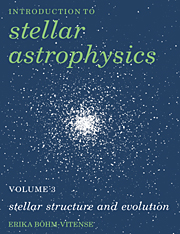Book contents
- Frontmatter
- Contents
- Preface
- 1 Introduction
- 2 Hydrostatic equilibrium
- 3 Thermal equilibrium
- 4 The opacities
- 5 Convective instability
- 6 Theory of convective energy transport
- 7 Depths of the outer convection zones
- 8 Energy generation in stars
- 9 Basic stellar structure equations
- 10 Homologous stars in radiative equilibrium
- 11 Influence of convection zones on stellar structure
- 12 Calculation of stellar models
- 13 Models for main sequence stars
- 14 Evolution of low mass stars
- 15 Evolution of massive stars
- 16 Late stages of stellar evolution
- 17 Observational tests of stellar evolution theory
- 18 Pulsating stars
- 19 The Cepheid mass problem
- 20 Star formation
- Appendix Radiative energy transport in stars
- Problems
- References
- Index
20 - Star formation
Published online by Cambridge University Press: 08 January 2010
- Frontmatter
- Contents
- Preface
- 1 Introduction
- 2 Hydrostatic equilibrium
- 3 Thermal equilibrium
- 4 The opacities
- 5 Convective instability
- 6 Theory of convective energy transport
- 7 Depths of the outer convection zones
- 8 Energy generation in stars
- 9 Basic stellar structure equations
- 10 Homologous stars in radiative equilibrium
- 11 Influence of convection zones on stellar structure
- 12 Calculation of stellar models
- 13 Models for main sequence stars
- 14 Evolution of low mass stars
- 15 Evolution of massive stars
- 16 Late stages of stellar evolution
- 17 Observational tests of stellar evolution theory
- 18 Pulsating stars
- 19 The Cepheid mass problem
- 20 Star formation
- Appendix Radiative energy transport in stars
- Problems
- References
- Index
Summary
Introduction
The fact that we see massive, luminous stars which cannot be older than about 106 years tells us that stars must have been formed within the last million years. In association with these luminous young stars we often see some peculiar stars with emission lines, called the T Tauri stars (see Volume 1). These can therefore be assumed to be young stars also. They have lower luminosities and are more red than the massive O and B stars but are considerably more luminous than main sequence stars of the same color. Because of their lower luminosities they must have lower masses than the O and B stars. For the lower mass stars the contraction times are longer, as we have seen in Chapter 2, because these stars cannot radiate away the surplus gravitational energy as fast as the more luminous, massive stars. If these lower mass T Tauri stars were formed at the same time as their more massive associates they have not had enough time to contract to the main sequence during the main sequence lifetime of the massive stars. Lower mass stars must therefore still be in the contraction phase. It is then reasonable to assume that these T Tauri stars are young stars still in the contraction phase.
Both kinds of stars, the massive O main sequence stars and the less massive young T Tauri stars, appear in association with large dust complexes, i.e. regions of high density where many interstellar molecules are formed. It thus appears that new stars may be born in regions of high density interstellar material.
- Type
- Chapter
- Information
- Introduction to Stellar Astrophysics , pp. 245 - 265Publisher: Cambridge University PressPrint publication year: 1992

